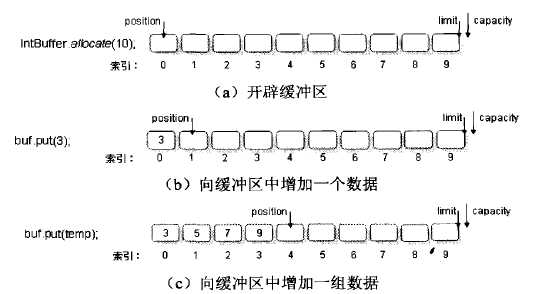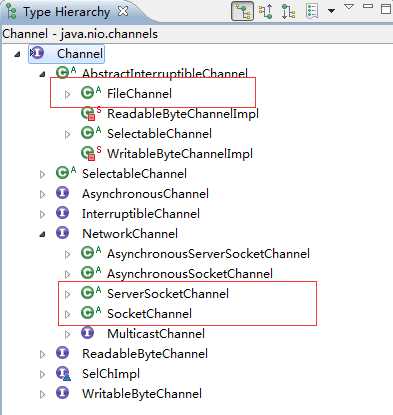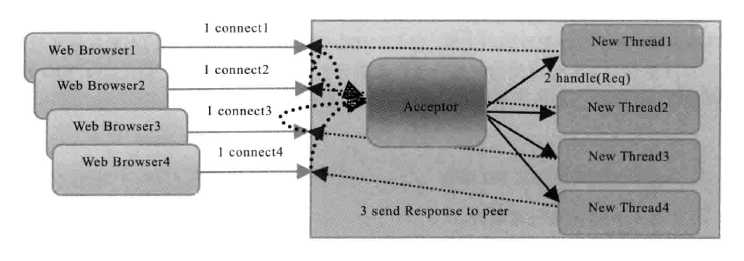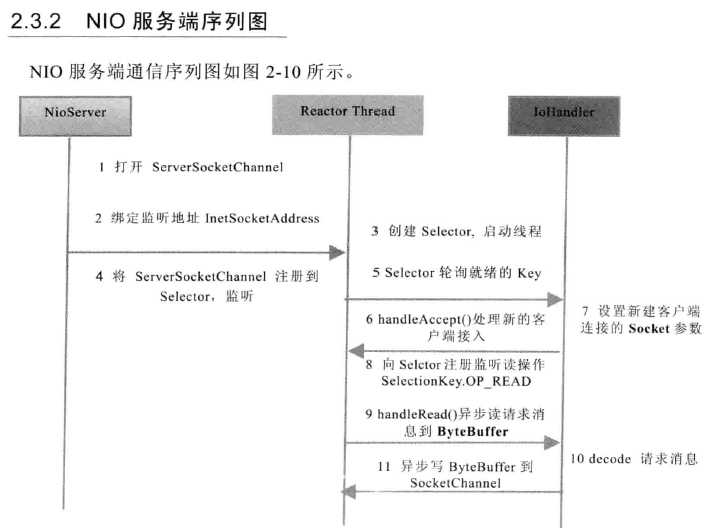标签:空闲 .so nio io操作 server config time() readline null

IntBuffer buf = IntBuffer.allocate(10) ; // 准备出10个大小的缓冲区 System.out.print("1、写入数据之前的position、limit和capacity:") ; System.out.println("position = " + buf.position() + ",limit = " + buf.limit() + ",capacty = " + buf.capacity()) ; int temp[] = {5,7,9} ;// 定义一个int数组 buf.put(3) ; // 设置一个数据 buf.put(temp) ; // 此时已经存放了四个记录 System.out.print("2、写入数据之后的position、limit和capacity:") ; System.out.println("position = " + buf.position() + ",limit = " + buf.limit() + ",capacty = " + buf.capacity()) ; buf.flip() ; // 重设缓冲区 // postion = 0 ,limit = 原本position System.out.print("3、准备输出数据时的position、limit和capacity:") ; System.out.println("position = " + buf.position() + ",limit = " + buf.limit() + ",capacty = " + buf.capacity()) ; System.out.print("缓冲区中的内容:") ; while(buf.hasRemaining()){ int x = buf.get() ; System.out.print(x + "、") ; }



File file1 = new File("d:" + File.separator + "note.txt") ; File file2 = new File("d:" + File.separator + "outnote.txt") ; FileInputStream input = null ; FileOutputStream output = null ; output = new FileOutputStream(file2) ; input = new FileInputStream(file1) ; FileChannel fout = null ; // 声明FileChannel对象 FileChannel fin = null ; // 定义输入的通道 fout = output.getChannel() ; // 得到输出的通道 fin = input.getChannel() ; // 得到输入的通道 ByteBuffer buf = ByteBuffer.allocate(1024) ; int temp = 0 ; while((temp=fin.read(buf))!=-1){ buf.flip() ; fout.write(buf) ; buf.clear() ; // 清空缓冲区,所有的状态变量的位置恢复到原点 }



public class TimeServer { public static void main(String[] args) throws IOException { int port = 8080; if (args != null && args.length > 0) { try { port = Integer.valueOf(args[0]); } catch (NumberFormatException e) { } } ServerSocket server = null; try { server = new ServerSocket(port); System.out.println("The time server is start in port : " + port); Socket socket = null; while (true) { socket = server.accept(); new Thread(new TimeServerHandler(socket)).start(); } } finally { if (server != null) { System.out.println("The time server close"); server.close(); server = null; } } } } public class TimeServerHandler implements Runnable { private Socket socket; public TimeServerHandler(Socket socket) { this.socket = socket; } public void run() { BufferedReader in = null; PrintWriter out = null; try { in = new BufferedReader(new InputStreamReader( this.socket.getInputStream())); out = new PrintWriter(this.socket.getOutputStream(), true); String currentTime = null; String body = null; while (true) { body = in.readLine(); if (body == null) break; System.out.println("The time server receive order : " + body); currentTime = "QUERY TIME ORDER".equalsIgnoreCase(body) ? new java.util.Date( System.currentTimeMillis()).toString() : "BAD ORDER"; out.println(currentTime); } } catch (Exception e) { if (in != null) { try { in.close(); } catch (IOException e1) { e1.printStackTrace(); } } if (out != null) { out.close(); out = null; } if (this.socket != null) { try { this.socket.close(); } catch (IOException e1) { e1.printStackTrace(); } this.socket = null; } } } }
public class TimeServer { public static void main(String[] args) throws IOException { int port = 8080; if (args != null && args.length > 0) { try { port = Integer.valueOf(args[0]); } catch (NumberFormatException e) { } } ServerSocket server = null; try { server = new ServerSocket(port); System.out.println("The time server is start in port : " + port); Socket socket = null; TimeServerHandlerExecutePool singleExecutor = new TimeServerHandlerExecutePool( 50, 10000);// 创建IO任务线程池 while (true) { socket = server.accept(); singleExecutor.execute(new TimeServerHandler(socket)); } } finally { if (server != null) { System.out.println("The time server close"); server.close(); server = null; } } } } public class TimeServerHandlerExecutePool { private ExecutorService executor; public TimeServerHandlerExecutePool(int maxPoolSize, int queueSize) { executor = new ThreadPoolExecutor(Runtime.getRuntime() .availableProcessors(), maxPoolSize, 120L, TimeUnit.SECONDS, new ArrayBlockingQueue<java.lang.Runnable>(queueSize)); } public void execute(java.lang.Runnable task) { executor.execute(task); } }



public class TimeServer { public static void main(String[] args) throws IOException { int port = 8080; if (args != null && args.length > 0) { try { port = Integer.valueOf(args[0]); } catch (NumberFormatException e) { // 采用默认值 } } MultiplexerTimeServer timeServer = new MultiplexerTimeServer(port); new Thread(timeServer, "NIO-MultiplexerTimeServer-001").start(); } } public class MultiplexerTimeServer implements Runnable { private Selector selector; private ServerSocketChannel servChannel; private volatile boolean stop; public MultiplexerTimeServer(int port) { try { selector = Selector.open(); servChannel = ServerSocketChannel.open(); servChannel.configureBlocking(false); servChannel.socket().bind(new InetSocketAddress(port), 1024); servChannel.register(selector, SelectionKey.OP_ACCEPT); System.out.println("The time server is start in port : " + port); } catch (IOException e) { e.printStackTrace(); System.exit(1); } } public void run() { while (!stop) { try { selector.select(1000); Set<SelectionKey> selectedKeys = selector.selectedKeys(); Iterator<SelectionKey> it = selectedKeys.iterator(); SelectionKey key = null; while (it.hasNext()) { key = it.next(); it.remove(); try { handleInput(key); } catch (Exception e) { if (key != null) { key.cancel(); if (key.channel() != null) key.channel().close(); } } } } catch (Throwable t) { t.printStackTrace(); } } // 多路复用器关闭后,所有注册在上面的Channel和Pipe等资源都会被自动去注册并关闭,所以不需要重复释放资源 if (selector != null) try { selector.close(); } catch (IOException e) { e.printStackTrace(); } } private void handleInput(SelectionKey key) throws IOException { if (key.isValid()) { // 处理新接入的请求消息 if (key.isAcceptable()) { // Accept the new connection ServerSocketChannel ssc = (ServerSocketChannel) key.channel(); SocketChannel sc = ssc.accept(); sc.configureBlocking(false); // Add the new connection to the selector sc.register(selector, SelectionKey.OP_READ); } if (key.isReadable()) { // Read the data SocketChannel sc = (SocketChannel) key.channel(); ByteBuffer readBuffer = ByteBuffer.allocate(1024); int readBytes = sc.read(readBuffer); if (readBytes > 0) { readBuffer.flip(); byte[] bytes = new byte[readBuffer.remaining()]; readBuffer.get(bytes); String body = new String(bytes, "UTF-8"); System.out.println("The time server receive order : " + body); String currentTime = "QUERY TIME ORDER" .equalsIgnoreCase(body) ? new java.util.Date( System.currentTimeMillis()).toString() : "BAD ORDER"; doWrite(sc, currentTime); } else if (readBytes < 0) { // 对端链路关闭 key.cancel(); sc.close(); } else ; // 读到0字节,忽略 } } } private void doWrite(SocketChannel channel, String response) throws IOException { if (response != null && response.trim().length() > 0) { byte[] bytes = response.getBytes(); ByteBuffer writeBuffer = ByteBuffer.allocate(bytes.length); writeBuffer.put(bytes); writeBuffer.flip(); channel.write(writeBuffer); } } public void stop() { this.stop = true; } }
标签:空闲 .so nio io操作 server config time() readline null
原文地址:http://www.cnblogs.com/liouwei4083/p/6284495.html